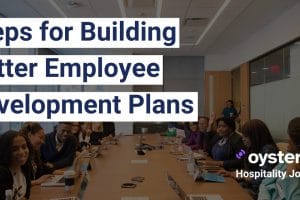Face it — your restaurant is going to have a negative online review one way or another. But whether it’s from a misunderstanding or just poor service, your response can make or break your restaurant’s reputation. We’re not even exaggerating.
This article discusses how to respond to negative restaurant reviews from people online. We’ve also included steps you can take as a restaurant owner to help you make the best out of this delicate situation and avoid getting bad reviews in the future.
Impact of Bad Reviews on Your Restaurant
About 75% of the total restaurant industry is affected by negative reviews, making it the most heavily impacted in the United States compared to other industries like hotels, clinics and hospitals.
[Source: Modern Restaurant Management]
This graph is interactive. Hover your mouse over different parts of the graph to see detailed data.
In fact, according to Modern Restaurant Management, bad reviews can cause you to lose about 70% of your potential customers. This means that one negative review can cost you about 30 customers. These losses could then snowball, leading to even more potential patrons lost.
Things get even worse when customers leave bad reviews for restaurants with few or no reviews, according to a study published in Papers in Applied Geography. These establishments are usually newer and have no online presence yet.
If someone leaves a bad review in this case, their overall rating is drastically affected.
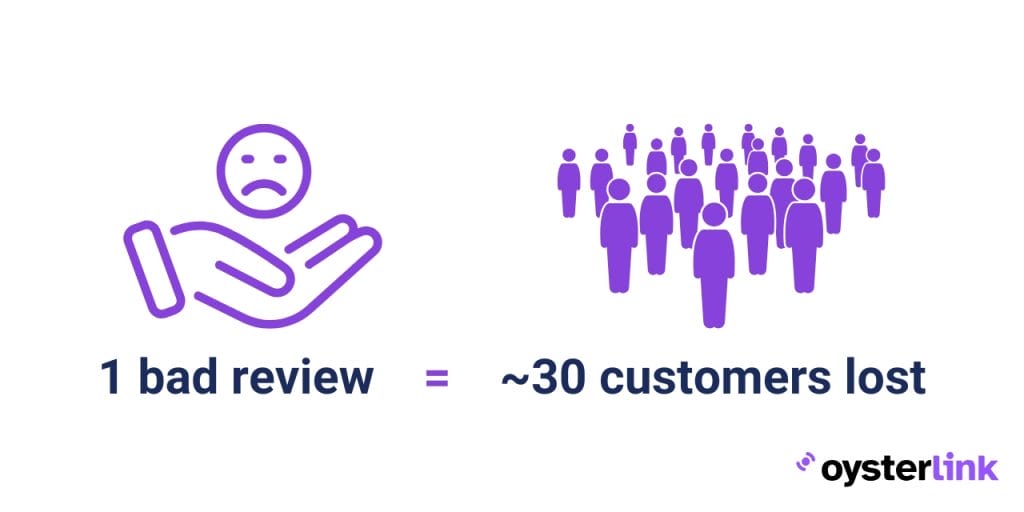
6 Tips for How To Respond to Negative Restaurant Reviews Correctly
Negative reviews can definitely make us panic, but it’s not always a bad thing. Being able to respond appropriately to bad reviews can demonstrate your willingness and proactive approach to ensuring customer satisfaction.
This can not only avoid bigger problems for your establishment, but it can also improve your restaurant’s reputation in the long term. Here are six strategies to consider when writing your responses.
1. Respond Quickly
Similar to how your customers don’t like to wait in line for too long, they also won’t be happy if you leave their negative reviews hanging.
For example, you can’t really respond after six weeks when a bad review is talking about finding hair in the food from your restaurant. This is due to the urgency of the issue and the fact that if you leave the review unanswered, more and more people will get to read it, thinking it’s a normal incident in your restaurant.
About 90% of consumers read fewer than 10 reviews before forming their own opinion about the business. Keep in mind that the most recent reviews are the ones they’re more likely to read. If you leave something urgent unattended for long, it’s bound to impact your potential customers’ decisions negatively.
Moreover, a response within the first 24 hours can also be a good sign for the customer that you’re taking things seriously.
2. Use Specific Details
When responding to a customer, give it a personal touch. Make sure to mention specific details they discussed in their review so they won’t think you’re sending just a generic response.
You can do this by mentioning their name instead of just “Sir” or “Ma’am.” You can also reiterate the issue they raised, the specific staff members they weren’t happy with or the dish they found salty.
Example:
“Hi, [Customer Name]. Thank you for your feedback regarding the steak you ordered last week. We’re sorry to hear it wasn’t cooked to your liking. We will address this with our kitchen team and make sure your next order is just the way you like it.”
Such specific details help build rapport and signal genuine engagement.
3. Apologize (i.e., Do Not Argue)
In the restaurant industry, the customer is (almost) always right. Make sure you acknowledge their criticism in a non-defensive tone. The last thing you want from your response is to blow up the conversation even further or make the customer angrier.
Keep in mind that your response should be about something other than who is right and wrong. Your response is a way for you to validate the customer’s experience and present a resolution.
Example:
“Hello, [Customer Name]. We’re deeply sorry for the misunderstanding regarding your order. Thank you for bringing it to our attention. Could you provide more details about the issue so we can ensure it doesn’t happen again?”
This approach not only addresses the complaint but also invites further dialogue.
4. Thank the Customer for Their Time
Reviews are important for any restaurant that’s marketing itself. Maintain a grateful tone when communicating with your customers, even when their reviews are negative, as they took the time to write about your establishment.
By expressing gratitude, you foster goodwill with your customers and indicate your commitment to improvement.
Example:
“Thank you for taking the time to share your thoughts, [Customer Name]. We appreciate your feedback as it helps us provide the service you deserve.”
Such acknowledgments can make customers feel valued and more likely to return.
5. Offer Additional Support
Don’t just say sorry. Mean it by offering specific steps toward resolution. This can involve inviting the customer back for a complimentary meal or providing a direct contact for further assistance.
Example:
“We would love the opportunity to make this right for you. Please reach out to our Restaurant Manager at [contact information], and we’d be happy to discuss your concerns further. We hope to see you again soon!”
This shows that you’re not just responding for show; you’re genuinely interested in resolving the issue.
6. Use Proper Grammar, Spelling and Punctuation
Professionalism matters in every communication, including responses to reviews. Clear, correct language enhances your credibility and reflects your restaurant’s standards.
Even if you’re offering the best resolution to your customers, they can easily judge you and forget about what you said when you make “funny” spelling errors.
Example:
Instead of: “were sorry you didn’t like your meal but some costumers did,”
Write: “We apologize that your meal did not meet your expectations. We value all feedback and will strive to improve.”
A well-crafted response boosts your restaurant’s professional image and shows your customers that you care about the smallest details.
Leveraging Positive Reviews to Mitigate Negative Feedback
While addressing negative reviews is crucial, highlighting positive feedback can help balance your restaurant’s online reputation. Encourage satisfied customers to share their experiences on review platforms. A higher volume of positive reviews can dilute the impact of negative ones and provide potential patrons with a more balanced perspective. Consider implementing strategies such as loyalty programs or incentives to motivate happy customers to leave positive reviews.
Sample Bad Reviews and How To Respond (Examples!)
Here are some real-life examples of how you can respond to a bad review about your restaurant.
Note: Reviews below are taken from Yelp. Names of people and restaurants have been omitted for anonymity.
Problem 1: Expensive Food

Response: “We’re really sorry to hear that your order didn’t meet your expectations. It’s disappointing to know that you felt the portions weren’t worth the price you paid.
We strive to provide good value and quality, and it sounds like we could have done better this time. Your feedback is important to us, and we’ll definitely look into this to improve.
We hope you’ll consider giving us another try.”
Problem 2: Insufficient Staff
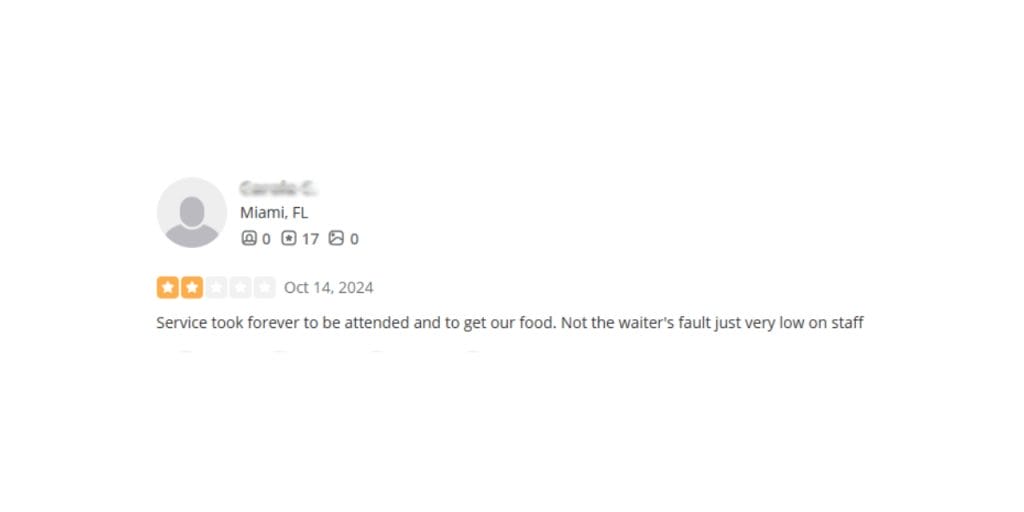
Response: “Thank you for your feedback. We sincerely apologize for the long wait times during your visit. While we strive to provide excellent service, we recognize that our staffing challenges negatively affected your experience.
We’re actively working to improve this situation. We hope you’ll give us another chance to serve you better in the future.”
Problem 3: Poorly Trained Staff
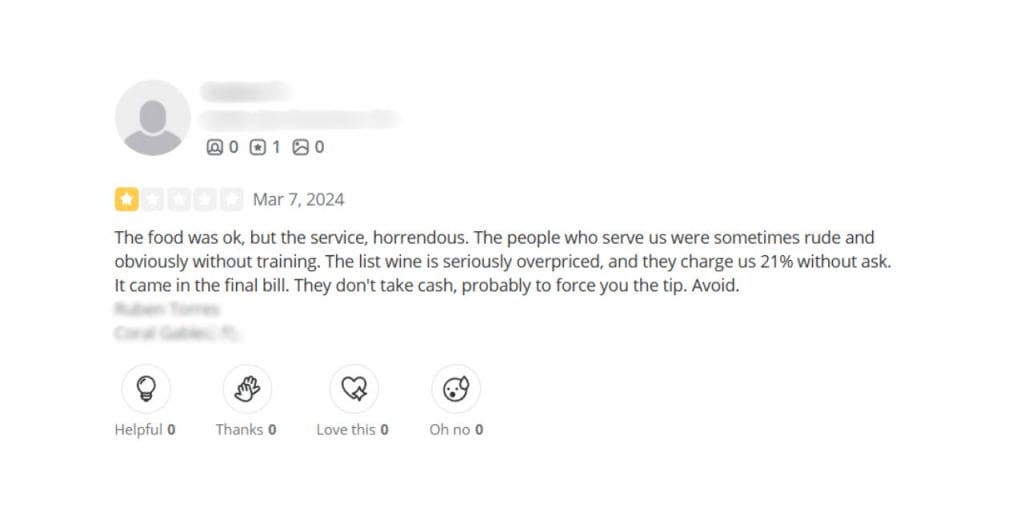
Response: “Thank you for your feedback. We’re sorry to hear that your experience with our service was not up to standard. We always aim to provide friendly and professional service, so it’s very concerning to hear that our staff appeared untrained and rude.
We’ll address this with our team to ensure everyone receives the proper training. Regarding the wine pricing and automatic gratuity, we will review our policies to ensure clarity for our guests.
We appreciate your input and hope you’ll consider giving us another chance to improve your experience.”
Problem 4: Miscommunication in Pricing
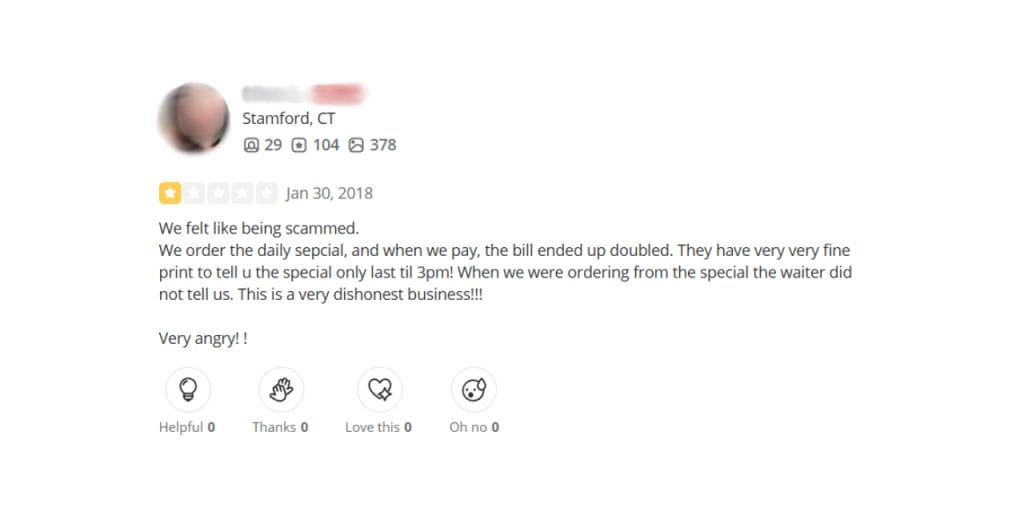
Response: “We’re really sorry to hear that you felt misled about our daily special. It’s frustrating when things aren’t clear, and I apologize for any confusion with the fine print.
We’ll definitely work on improving our communication so our staff provides all the details upfront.
Thank you for bringing this to our attention, and we hope you’ll consider giving us another chance to make things right.”
Sample Bad Reviews With Great Responses
Now that we’ve seen some bad apples, let’s appreciate restaurant owners with the right feedback management practices.
Example 1
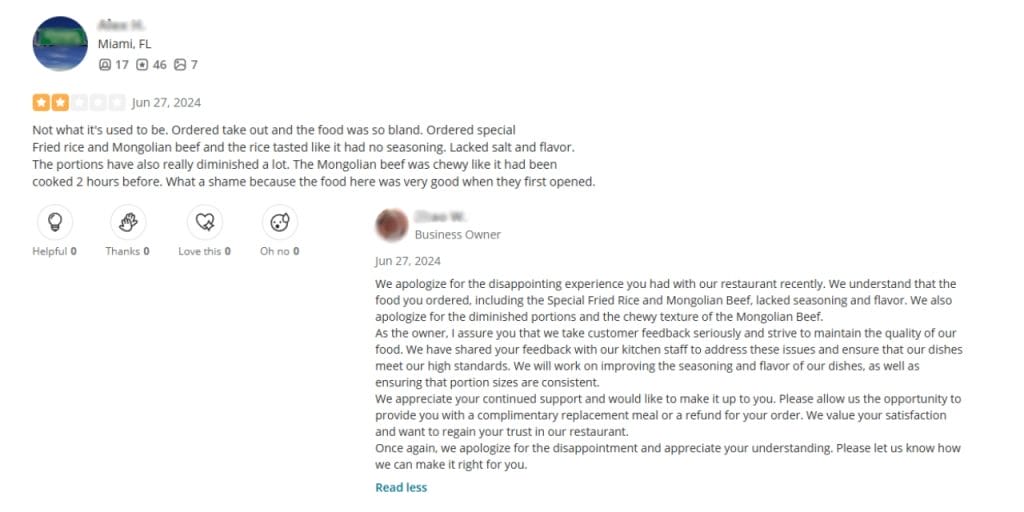
Example 2
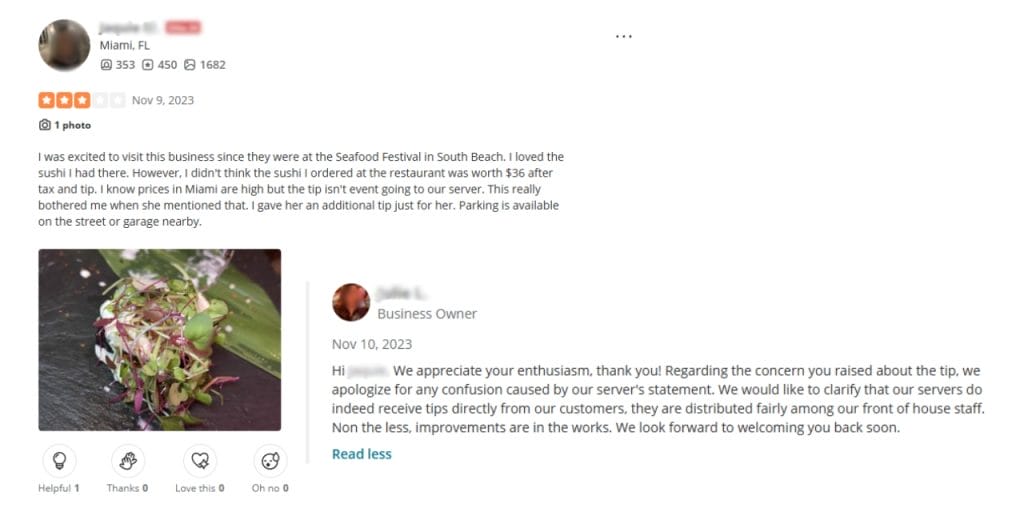
Example 3
Negative Review: “The service was slow, and my meal was cold by the time it arrived. Very disappointed.”
Response: Suggested Response: “Dear [Customer Name], thank you for bringing this to our attention. We sincerely apologize for the delay and the temperature of your meal during your recent visit. This is not reflective of our usual standards, and we are taking steps to address these issues with our team.
We hope you’ll consider giving us another chance to provide you with the quality experience we strive for. Please feel free to contact us directly at [contact information] to discuss this further.”
The responses in the examples above addressed each concern the customer had. They also thanked the customer for their feedback, explained the restaurant’s standards and how the problem goes against these, apologized and offered additional support.
Most importantly, they used clear language. Even though there were a few typos, these were kept at a minimum.
How To Avoid Bad Restaurant Reviews
Now that you know what happens when you get a bad review, it’s crucial to fix these reviews as soon as possible. You’d also need to improve your overall rating by making sure that the newer reviews written about your restaurant are more positive than ever.
Accomplish this by doing the following:
1. Show You’ve Learned From Previous Bad Reviews
Don’t make empty promises to customers if you’re not serious about following through. While knowing how to respond to bad reviews is good, taking action to resolve the issue is the best approach.
If customers notice that all the reviews of your restaurant sound the same, it suggests a lack of genuine concern for their satisfaction.
So, if reviews are saying your staff members are rude, train them. If the food is subpar, consult the Chef. Actively solving these problems highlighted by previous customers will help avoid recurring negative feedback, and improve overall customer satisfaction and your restaurant’s rating.
2. Inform Staff of Common Customer Complaints
Don’t leave your staff in the dark, especially if they’re the ones at the frontline of customer interactions. Be honest about negative feedback and firm when discussing what to do moving forward.
Give realistic goals and provide specific steps so they can accomplish them. Talk about what you can do as the restaurant owner and how you can help them. This is also a good opportunity to hold training sessions on possible weaknesses.
3. Make Sure You Have the Right Leaders
Those you put on leadership roles, like your Assistant Restaurant Manager or Kitchen Manager, hold a crucial role in motivating your restaurant employees and leading by example.
Keep in mind that if your leaders are not doing their jobs correctly, then expect this to have a trickle-down effect on junior-level employees. That said, your leaders must do their part in upholding a culture of excellence and accountability.
Monitoring and Managing Online Reputation
Proactively managing your restaurant’s online presence is essential in today’s digital age. Regularly monitor review platforms such as Yelp, TripAdvisor, and Google Reviews to stay informed about customer feedback. Utilize online reputation management tools to streamline this process and receive real-time alerts. By staying vigilant, you can address negative reviews promptly and engage with positive ones, demonstrating your commitment to customer satisfaction.
Conclusion
Negative reviews may feel like a nightmare, but they don’t have to be the end of the world. In fact, they can be your greatest opportunity to show the world what your restaurant is truly about. The way you handle criticism — whether it’s a burnt steak or slow service — can turn dissatisfied customers into lifelong supporters and skeptical potential guests into loyal patrons.
So, the next time you see a negative review, don’t panic. Pause, reflect, and use the strategies shared here to transform a tough situation into your restaurant’s next big win. Your customers — and your reputation — will thank you.
Get Tips on Restaurant Operations With OysterLink
OysterLink offers recruitment advice to restaurant owners and hiring managers, tips on restaurant operations, restaurant staff retention strategies and more. We also advertise restaurant jobs for free.
Fill out this form to start publishing your jobs and get access to our large talent pool of restaurant and hospitality workers!
How To Respond to Negative Restaurant Reviews FAQs
Start by training your staff on common scenarios that lead to negative reviews, such as long wait times, food issues, or poor communication. Create a “customer service playbook” that outlines how to handle these situations in real-time. Regularly hold team meetings to discuss feedback and emphasize how critical their role is in ensuring a positive customer experience.
Ask directly but politely. For instance, after a great dining experience, your servers can say, “We’d love it if you could share your experience with us on [review platform].” You can also display QR codes on receipts or at tables that link directly to your review pages. Incentivize happy customers with loyalty points or small discounts for leaving honest reviews.
Even if a review feels unfair, respond professionally. Say something like: “Thank you for your feedback. We’re sorry to hear about your experience and would love the chance to learn more. Please contact us directly at [email/phone] so we can investigate further.” This shows potential customers that you’re attentive, even if the review isn’t accurate.
Focus on boosting the volume of positive reviews. Encourage satisfied customers to leave feedback while addressing recurring complaints highlighted in negative reviews. You can also run community engagement campaigns, such as hosting local events, to generate goodwill and attract positive attention. Remember, consistency in excellent service is key to long-term improvement.
Yes, if the issue seems too complex to resolve publicly, invite the reviewer to continue the conversation privately. For example: “We’d like to resolve this for you—please reach out to us directly at [contact info].” This not only protects your restaurant’s image but also gives you a chance to offer personalized resolutions, such as a complimentary meal or a private apology.

Written by Jericka Orellano
Jericka is a published author who has had a decade of experience in publishing, editorial work, localization and media. Having spent eight years as a professional trainer and supervisor for other writers and editors, she excels in research, copyediting, proofreading and quality assurance. She now works with OysterLink as a content specialist.

Reviewed by Stefan Petrov
With over 10 years of experience as a writer and editor, Stefan has worked in the automotive, IT, health and hospitality industries. Familiar with Google Search Console and other SEO tools like Ahrefs and Semrush, Stefan uses his experience to create content that’s visually appealing to the user but also ranks in the SERPs.


